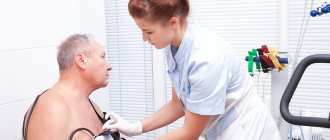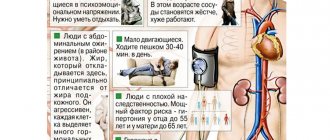What is hypertension?
A syndrome in which there is a regular, long-term and persistent increase in blood pressure is called “arterial hypertension” or “hypertension”. This syndrome may appear:
- in case of hypertension (HTN) - a primary independent disease;
- for secondary (symptomatic) hypertension , which is a consequence of disruption of the functioning of various organs - kidneys, adrenal glands, thyroid gland and others.
Hypertension accounts for the majority of cases of hypertension. The etiology of hypertension is not reliably known, but it is based on primary functional disorders of the systems that regulate blood pressure.
Risk factors for developing hypertension include:
- hereditary predisposition;
- a sedentary lifestyle, which reduces the body’s adaptive capabilities and disrupts the functioning of the circulatory system;
- high body mass index. In obese people, the risk of developing hypertension increases 2-6 times;
- excess salt in the diet, which leads to the accumulation of excess fluid in the body, which increases the load on the cardiovascular system;
- drinking alcohol, smoking;
- elderly age. The older a person gets, the higher their risk of developing the disease.
It turns out that in most cases, bad habits lead to hypertension - physical inactivity, overeating, poor nutrition, nicotine and alcohol addiction. That is why hypertension is considered a pathology directly related to lifestyle, and changing it for the better is the main element of successful treatment.
The Recommendations retain the approach to determining the overall cardiovascular risk using SCORE, taking into account the fact that in patients with hypertension, this risk increases significantly in the presence of target organ damage associated with hypertension (especially left ventricular hypertrophy, CKD). Among the factors influencing the cardiovascular prognosis in patients with hypertension, the level of uric acid was added (more precisely, returned), early menopause, psychosocial and economic factors, and a resting heart rate of 80 beats/min or more were added. Asymptomatic target organ damage associated with hypertension includes moderate CKD with a glomerular filtration rate (GFR) <60 ml/min/1.73 m2, and severe CKD with a GFR <30 ml/min/1.73 m2 (calculated using the formula CKD-EPI), as well as severe retinopathy with hemorrhages or exudates, swelling of the optic nerve nipple. Asymptomatic kidney damage is also determined by the presence of microalbuminuria or an increased albumin/creatinine ratio in the urine. The list of established diseases of the cardiovascular system is supplemented by the presence of atherosclerotic plaques in imaging studies and atrial fibrillation.
An approach has been introduced to classify hypertension according to the stages of the disease (hypertension), taking into account the level of blood pressure, the presence of risk factors affecting the prognosis, target organ damage associated with hypertension, and comorbid conditions (Table 3).
The classification covers the range of blood pressure from high normal to grade 3 hypertension.
There are 3 stages of hypertension (hypertension). The stage of hypertension does not depend on the level of blood pressure, but is determined by the presence and severity of target organ damage.
Stage 1 (uncomplicated) - There may be other risk factors, but there is no end-organ damage. At this stage, patients with grade 3 hypertension are classified as high risk, regardless of the number of risk factors, as well as patients with grade 2 hypertension with 3 or more risk factors. The moderate-high risk category includes patients with stage 2 hypertension and 1-2 risk factors, as well as stage 1 hypertension with 3 or more risk factors. The moderate risk category includes patients with grade 1 hypertension and 1-2 risk factors, grade 2 hypertension without risk factors. Patients with high normal blood pressure and 3 or more risk factors correspond to low-moderate risk. The remaining patients were classified as low risk.
Stage 2 (asymptomatic) implies the presence of asymptomatic target organ damage associated with hypertension; CKD stage 3; DM without target organ damage and assumes the absence of symptomatic cardiovascular diseases. The state of target organs corresponding to stage 2, with high normal blood pressure, places the patient in the moderate-high risk group, with increased blood pressure of 1-2 degrees - in the high-risk category, 3 degrees - in the high-very high risk category.
Stage 3 (complicated) is determined by the presence of symptomatic cardiovascular diseases, CKD stage 4 or higher, and diabetes with target organ damage. This stage, regardless of blood pressure level, places the patient in the very high risk category.
Assessment of organ damage is recommended not only to determine risk, but also for monitoring during treatment. Changes in electro- and echocardiographic signs of left ventricular hypertrophy and GFR during treatment have a high prognostic value; moderate - dynamics of albuminuria and ankle-brachial index. Changes in the thickness of the intima-medial layer of the carotid arteries have no prognostic significance. There is insufficient data to conclude on the prognostic value of pulse wave velocity dynamics. There is no data on the significance of the dynamics of signs of left ventricular hypertrophy according to magnetic resonance imaging.
The role of statins has been emphasized to reduce cardiovascular risk, including greater risk reduction while achieving BP control. Antiplatelet therapy is indicated for secondary prevention and is not recommended for primary prevention in patients without cardiovascular disease.
What blood pressure is considered high?
Blood pressure is a factor that gives the specialist important information about the functioning of the circulatory system. Blood pressure levels are affected by:
- The magnitude of cardiac output, which in turn depends on the contractility of the left ventricle of the myocardium, heart rate and other parameters.
- Total peripheral vascular resistance (TPVR) is an indicator that reflects the ability of blood vessels to resist blood pressure from the inside. OPSS depends on the tone, stiffness of blood vessels, and blood viscosity.
- Circulating blood volume.
Blood pressure has upper and lower limits. The upper pressure is called "systolic", the lower - "diastolic". The first value reflects the force of blood pressure in the arteries during myocardial contraction, the second - at the moment of relaxation of the heart muscle.
The ideal pressure is considered to be 120/80 mm Hg. Art. Depending on the individual characteristics of a person (gender, age, physical activity), a slight deviation of these values down or up is allowed. However, in any person, blood pressure should not exceed 140/90 mmHg. Art. Higher levels are potentially dangerous and can lead to functional and organic damage to target organs.
Causes of hypertension grade 2 risk 3
It is important to know!
STILL STRUGGLE WITH ARTERIAL HYPERTENSION INCORRECTLY? The first bioavailable drug with proven effectiveness Read more »
Doctors are of the opinion that the main risk group for morbidity is people who have reached the age of 50-55 years and have acquired natural wear and tear on the walls of blood vessels throughout their lives. They have ceased to fully cope with their function of transporting blood, their valves have lost their former elasticity and the person begins to suffer from hypertension of the indicated degree. In addition, there are other causative factors that lead to the development of arterial hypertension of degree 2 with a risk of 3, and some of them occur in patients of all age categories. The causes of this disease of the cardiovascular system are associated with the presence of the following conditions and concomitant diseases of the body:
1. Atherosclerosis of the arteries.
In a healthy state, the main blood vessels, which are the arteries, have natural elasticity. If there is an excessive load on their walls, they expand, and then, after eliminating the stress factors, they return to their original position. A person practically does not feel any discomfort and this is considered the norm. If for some reason the walls of the vascular tissue begin to collapse and undergo atherosclerotic changes, then the artery loses its ability to behave elastically and the slightest nervous or physical stress causes an increase in blood pressure.
2. Heredity.
Hypertension grade 2, risk 3, refers to a group of diseases that can affect a person’s blood vessels due to his genetic predisposition to the manifestation of this disease. If the father or mother suffered from high blood pressure, then the probability that the child will develop this disease is 85%. This is a very high indicator of the possible development of the disease and cannot be ignored. The hereditary form of hypertension of this degree is very difficult to treat, since the presence of high blood pressure in the body is due to a pre-formed genetic program.
3. Obesity.
In people who are overweight, the likelihood of developing stage 2 hypertension with a risk of stage 3 is several times higher than in a person of average build or excessively thin. The thing is that with obesity, fatty acids are released into the bloodstream, from which cholesterol plaques are formed. Essentially, these are fragments of fat cells, clustered into dense formations, which settle on the walls of blood vessels and complicate the passage of blood through the body. This leads to the development of hypertension.
4. Hormonal imbalance.
A stable background of male and female sex hormones, as well as other secretions produced by the glands of the endocrine system, ensures not only that a person has an excellent mood, but also normal blood pressure. If the patient suffers from pathologies of the thyroid, pancreas, or has diseases of the adrenal cortex, then an excess release or deficiency of hormone synthesis occurs, which leads to the gradual development of arterial hypertension of degree 2 with a risk of 3.
5. Bad habits.
The presence of bad habits in a patient such as alcohol abuse, smoking, taking drugs, also destroys blood vessels and is an essential prerequisite for the development of hypertension of the appropriate degree, when the upper pressure goes off scale to 160 units and above. The longer a person’s life is associated with these harmful habits, the greater the risk of developing this disease and the development of its complications.
6. Oncological formations.
We are talking about malignant formations that, under the influence of certain negative environmental factors, led to their growth inside the main vessel. Cancerous tumors most often appear in the arteries. As the foreign tumor develops, a natural blockage of stable blood flow occurs and, as a result, the patient begins to experience symptoms indicating the presence of arterial hypertension. After surgery and removal of the tumor body, signs of arterial hypertension completely disappear.
The manifestation of hypertension in a patient of stage 2 with a risk of 3 is greatly influenced by the diet and daily meals consumed. When fatty foods of animal origin predominate, as well as an excessive amount of table salt, this also negatively affects the health of the heart and blood vessels. If a person does not reconsider his gastronomic preferences, then after 5-7 years the first signs of hypertension begin to appear.
Stages of pathology
Depending on the degree of increase in blood pressure, three stages of hypertension are distinguished ⇓⇓⇓
First stage of headache
In the first stage of hypertension, high blood pressure can independently return to normal values. As a rule, at this stage of the disease, target organs are not affected and there are no complications.
Second stage of headache
At the second stage of hypertension, a person may experience various pathological changes:
- thickening of the walls of the left ventricle of the myocardium, which often leads to heart failure and coronary heart disease;
- atherosclerosis - the formation of atherosclerotic plaques on the walls of blood vessels that impair blood circulation;
- retinal angiopathy is a violation of the tone of the vessels that supply the iris of the eye.
At the second stage of hypertension, normalization of blood pressure is possible only with the help of medications.
Third stage of headache
The third stage of hypertension can lead to severe complications:
- stroke - acute disruption of blood supply to the brain;
- aortic dissection - rupture of the largest artery. If the aortic wall is completely ruptured, massive blood loss occurs;
- myocardial infarction - necrosis of a section of the heart muscle;
- renal failure - decreased excretory capacity of the kidneys.
In the third degree of hypertension, blood pressure is difficult to normalize even with the help of medications. A person may experience hypertensive crises, during which blood pressure rises sharply and urgent medical attention is required.
Hypertension stage 2, risk 3 – what is it?
What does grade 2 hypertension, risk 3, mean? This question worries the majority of patients who, after visiting a consultation with a general practitioner, were given this diagnosis. It is necessary to understand that the classification of hypertension according to the specified category with the assignment of 2 degrees and the possible occurrence of a risk of complications 3, provides for the presence of a pathological condition of the human cardiovascular system in the patient, characterized by the stable presence of high blood pressure within 160 units of the tonometer reading. This refers to the upper division of the measuring device.
Such blood pressure is quite difficult to stabilize with the help of traditional medications and folk remedies, which are used in most cases when a person begins a hypertensive crisis. People with strong walls of blood vessels may not feel significant discomfort for a long time due to the fact that the pressure rises to 160 units and complain only of a severe headache. The latter symptom can be successfully relieved by taking tableted analgesics and antispasmodics. As the great vessels lose their elasticity, the signs of hypertension intensify and become more and more disturbing to the patient. Ultimately, all this ends in a severe hypertensive crisis with the patient’s hospitalization in the inpatient general therapy department.
What symptoms may indicate hypertension?
As a rule, the disease is asymptomatic for a long time. In some cases, increased pressure is accompanied by:
- frequent heart rate;
- headaches, dizziness;
- weakness, fatigue;
- redness of the facial skin;
- increased sweating;
- blurred vision, ringing in the ears.
However, such symptoms are not specific to hypertension and may be signs of other diseases or fatigue. Therefore, pathology can be detected at an early stage only by regularly measuring blood pressure.
How is the disease diagnosed?
To diagnose arterial hypertension, a doctor needs to take several blood pressure measurements at different times of the day. If necessary, a specialist can prescribe ABPM - an instrumental study in which blood pressure is monitored throughout the day using a special device.
Differential diagnosis of hypertension occurs as follows:
- An examination of organs whose pathologies could cause increased blood pressure is performed. For example, the examination may include an ECG, ultrasound of the kidneys, and fundus examination.
- If secondary hypertension is excluded and a specific cause for the increase in blood pressure is not found, then a diagnosis of hypertension is made.
Diagnosis and treatment of hypertension
Diagnosis of the disease
Diagnosis of hypertension at the A-Media clinic is carried out using the following methods:
- blood pressure measurement
- ECG
- 24-hour ECG monitoring with blood pressure (Holter monitoring)
- echocardiography (echocardiography or ultrasound of the heart)
- Ultrasound of the abdominal cavity with kidneys
- Ultrasound Dopplerography of the BCA (ultrasound Dopplerography of brachiocephalic arteries and veins).
Treatments for hypertension
Treatment of hypertension in our clinic is planned by a qualified cardiologist only after an accurate diagnosis has been made.
First step: Our doctor will take measures to lower the patient's blood pressure.
Further therapy is planned individually based on the type of hypertension. Mild and moderate forms of the disease can be treated with medications. For severe hypertension, antihypertensive drugs are always prescribed. Lifestyle modification is a prerequisite.
Prevention measures
Measures to prevent hypertension include:
- regular physical activity;
- giving up alcohol and smoking;
- balanced diet.
- dosed consumption of table salt (no more than 5 g per day).
Also, do not forget to regularly measure your blood pressure with a tonometer, which will allow you to notice its increase in time and seek medical help.
Stage 2 hypertension and disability
Manifestations of hypertensive disease are not always completely removable. Especially often, people with a malignant form of the disease face the fact that treatment does not bring the desired effect. In this case, the person loses the ability to work fully and receives the status of a disabled person with a number of restrictions. The patient is prohibited from:
- work in extreme conditions;
- work more than 7 hours a day;
- be at heights and at high temperatures while working;
- experience stress and increased physical activity.
Disability, if the disease does not progress to stages 3 and 4, is temporary and is removed when the patient’s condition improves. If complications do not allow a full recovery, a person can work only in certain conditions that take into account the specifics of the course of the disease, for example, remotely.







